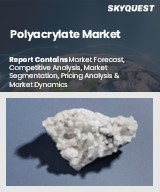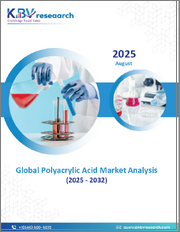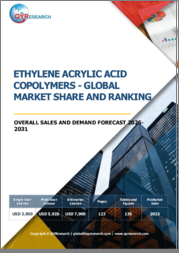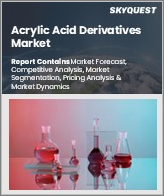
|
시장보고서
상품코드
1717809
바이오 아크릴산 시장 : 유형, 원료, 용도별 - 세계 예측(2025-2030년)Bio-Acrylic Acid Market by Type, Raw Material, Application - Global Forecast 2025-2030 |
||||||
바이오 아크릴산 시장의 2023년 시장 규모는 4억 7,893만 달러로 평가되었으며, 2024년에는 5억 2,218만 달러로 성장하고, CAGR은 9.46%, 2030년에는 9억 201만 달러에 달할 것으로 예측됩니다.
| 주요 시장 통계 | |
|---|---|
| 기준 연도 2023년 | 4억 7,893만 달러 |
| 추정 연도 2024년 | 5억 2,218만 달러 |
| 예측 연도 2030년 | 9억 201만 달러 |
| CAGR(%) | 9.46% |
바이오 아크릴산 시장은 혁신적인 화학과 지속가능한 관행이 결합된 역동적이고 진화하는 시장입니다. 전통적인 아크릴산의 특성과 바이오 기반 원료의 전례 없는 결합은 산업 부문 전반에서 응용 분야가 급증하고 소비자 수용을 촉진하고 있습니다. 최근 몇 년 동안 아크릴산 시장은 고성능을 달성하면서도 환경 발자국을 줄이는 것에 대한 관심이 높아지면서 르네상스를 경험하고 있습니다. 기술 발전과 참신한 가공 방법이 시장 침투를 가속화하여 품질과 환경 기준을 모두 충족하는 바이오 아크릴산 제품이 탄생하고 있습니다.
본 보고서에서는 먼저 바이오 아크릴산을 뒷받침하는 기초 화학의 개요뿐만 아니라, 규제 프레임워크부터 소비자 수요 동향까지 시장의 촉진요인을 포괄하는 종합적인 배경을 설정합니다. 또한, 온실가스 배출량 저감 및 생분해성 향상과 같은 비교우위에 대해서도 상세히 검토하여 보다 충실한 내용으로 구성되어 있습니다. 서론에서는 지속가능한 대체품 채택의 전략적 중요성을 강조하고 있습니다. 생산 기술 혁신의 중요성과 그에 따른 시장 역학 및 환경 지침과의 연계성은 이 분야의 현재 과제와 향후 전망을 이해할 수 있는 독특한 배경을 제공합니다.
이 보고서는 의사결정자와 업계 전문가들에게 공급망 의사결정, 가격 전략, 장기적인 시장 지속가능성에 영향을 미치는 주요 요인에 대한 중층적인 이해를 제공합니다. 이 책에 소개된 기본 주제와 변혁적 트렌드는 시장 세분화, 지역별 인사이트, 업계 선두주자, 전략적 시장 진입 및 확장을 위한 실행 가능한 권장사항에 대한 심도 있는 탐구의 장이 될 것입니다.
바이오 아크릴산 시장의 변화
최근 몇 년 동안 세계 바이오 아크릴산 시장은 혁신적인 변화로 인해 재정의되고 있습니다. 이러한 변화의 주요 요인은 기술 혁신, 환경 보호 및 지속가능한 제품에 대한 고객의 요구입니다. 전통적인 제조 방식은 에너지 소비를 줄이고 재생 불가능한 자원에 대한 의존도를 줄이는 것을 우선시하는 현대적이고 효율적인 기술로 재편되고 있습니다.
옥수수, 사탕수수와 같은 생물 유래 자원이 점점 더 중요한 역할을 하게 된 원료 조달의 혼란스러운 추세로 인해 상황은 진화해 왔습니다. 그 결과, 기업들은 환경 발자국을 줄일 뿐만 아니라 끊임없이 경쟁하는 시장에서 빠르게 진입할 수 있는 전략적 우위를 제공하는 대체 원료를 채택하고 있습니다. 촉매 설계, 공정 강화, 폐기물에서 가치로의 전환에 대한 혁신은 이러한 변화를 더욱 가속화하고 있습니다. 제조업체들은 현재 공정 효율을 더욱 정교하게 개선하여 제품 품질과 비용 경쟁력을 지속적으로 향상시키고 있습니다.
또한, 이러한 패러다임의 변화는 전 세계 규제 환경의 변화와도 맞물려 있습니다. 당국은 점점 더 엄격한 환경 규제를 의무화하고 있으며, 이는 지속가능한 화학 공정이 채택되는 속도에 영향을 미치고 있습니다. 이해관계자들은 생산 방식을 최적화하고 성장을 촉진하는 동시에 환경에 미치는 영향을 줄이기 위해 연구개발에 많은 투자를함으로써 이에 대응하고 있습니다. 요컨대, 현재 진행 중인 시장 구조의 변화는 보다 지속가능하고 수익성 높은 미래를 위한 무대를 마련하고, 기술 혁신, 신뢰성, 친환경적 관행에 대한 보상을 제공하는 경쟁 환경을 조성하고 있습니다.
세분화에 대한 심층적인 인사이트 알아보기
시장 세분화를 자세히 조사하면 바이오 아크릴산 분야의 수요 촉진요인과 비즈니스 기회의 풍부한 태피스트리가 드러납니다. 연구 조사는 유형, 원료, 용도 등 여러 요인에 따라 시장을 세분화하여 제품 개발 및 상품화의 모든 측면이 소비자 동향 및 기술 발전과 연계될 수 있도록 합니다.
유형에 따른 세분화를 살펴보면, 시장은 2-에틸헥실 아크릴산, 부틸 아크릴산, 엘라스토머, 에틸 아크릴산, 메틸 아크릴산 등 다양한 화학 유도체에 걸쳐 포괄적으로 조사되고 있습니다. 이들 성분은 각각 유연성 및 내구성 향상에서 우수한 접착력에 이르기까지 다양한 산업 응용 분야에서 요구되는 특정 성능 요구 사항을 충족하는 고유한 특성을 제공합니다. 유형 외에도 원재료에 따른 세분화는 조달 전략에 대한 중요한 인사이트를 제공합니다. 시장 조사는 옥수수 기반과 사탕수수 기반 원료의 역할을 비판적으로 평가하고, 이러한 재생 가능한 원료가 환경적으로 지속가능할 뿐만 아니라 기존 석유화학 경로에 비해 비용 효율적이라는 점을 강조합니다.
마찬가지로 중요한 것은 바이오 아크릴산의 다양한 산업 및 소비자 분야에 대한 적응성을 강조하는 용도에 따른 세분화입니다. 바이오 아크릴산은 접착제 및 실란트와 같은 고성능 제품, 건축용 접착제 및 감압 접착제, 건축용 페인트 및 산업용 페인트와 같은 페인트에 사용됩니다. 또한, 특히 식기 세제나 세탁 세제에 사용되는 경우 세제나 세정제에 배합되어 그 효능을 높일 수 있다는 장점도 있습니다. 컨슈머 케어 분야에서도 바이오 아크릴산은 성인용 요실금 용품, 기저귀, 생리대 등 퍼스널케어 제품에 적용되고 있습니다. 또한 섬유 산업은 기능성 섬유와 스마트 섬유로 분류되는 첨단 섬유 개발에 그 가능성을 활용하고 있습니다. 이러한 각 분야는 시장 도입을 촉진할 뿐만 아니라 다양한 산업의 다양한 수요에 대응하는 맞춤형 솔루션을 제공하고 있어 시장 상황은 광범위하고 미묘한 양상을 보이고 있습니다.
목차
제1장 서문
제2장 조사 방법
제3장 주요 요약
제4장 시장 개요
제5장 시장 인사이트
- 시장 역학
- 성장 촉진요인
- 성장 억제요인
- 기회
- 해결해야 할 과제
- 시장 세분화 분석
- Porter’s Five Forces 분석
- PESTLE 분석
- 정치
- 경제
- 사회
- 기술
- 법률
- 환경
제6장 바이오 아크릴산 시장 : 유형별
- 2-에틸헥실 아크릴레이트
- 부틸 아크릴레이트
- 엘라스토머
- 아크릴산 에틸
- 메틸 아크릴레이트
제7장 바이오 아크릴산 시장 : 원재료별
- 옥수수 유래 도
- 사탕수수 유래 원료
제8장 바이오 아크릴산 시장 : 용도별
- 접착제와 실란트
- 건설용 접착제
- 감압 접착제
- 코팅
- 건축용 코팅
- 산업용 코팅
- 세제와 세정 제품
- 식기용 세제
- 세탁 세제
- 퍼스널케어 제품
- 성인용 요실금 용품
- 기저귀
- 생리대
- 섬유
- 기능성 섬유
- 스마트 텍스타일
제9장 아메리카의 바이오 아크릴산 시장
- 아르헨티나
- 브라질
- 캐나다
- 멕시코
- 미국
제10장 아시아태평양의 바이오 아크릴산 시장
- 호주
- 중국
- 인도
- 인도네시아
- 일본
- 말레이시아
- 필리핀
- 싱가포르
- 한국
- 대만
- 태국
- 베트남
제11장 유럽, 중동 및 아프리카의 바이오 아크릴산 시장
- 덴마크
- 이집트
- 핀란드
- 프랑스
- 독일
- 이스라엘
- 이탈리아
- 네덜란드
- 나이지리아
- 노르웨이
- 폴란드
- 카타르
- 러시아
- 사우디아라비아
- 남아프리카공화국
- 스페인
- 스웨덴
- 스위스
- 튀르키예
- 아랍에미리트
- 영국
제12장 경쟁 구도
- 시장 점유율 분석, 2023
- FPNV 포지셔닝 매트릭스, 2023
- 경쟁 시나리오 분석
- 전략 분석과 제안
기업 리스트
- Archer Daniels Midland Company
- Arkema Group
- BASF SE
- Cargill, Incorporated
- GS Caltex Corporation
- Industrial Microbes, Inc.
- JINTEX Corporation Ltd.
- KSE, Inc.
- LG Chem Ltd.
- Lakril Technologies
- MBBT Chemical Company
- Mitsubishi Chemical Group Corporation
- Nippon Shokubai Co., Ltd.
- Novozymes A/S
- Procter & Gamble Company
- PTT Global Chemical Public Company Limited
- The Dow Chemical Company
- Vizag Chemical International
- Xerox Corporation
The Bio-Acrylic Acid Market was valued at USD 478.93 million in 2023 and is projected to grow to USD 522.18 million in 2024, with a CAGR of 9.46%, reaching USD 902.01 million by 2030.
| KEY MARKET STATISTICS | |
|---|---|
| Base Year [2023] | USD 478.93 million |
| Estimated Year [2024] | USD 522.18 million |
| Forecast Year [2030] | USD 902.01 million |
| CAGR (%) | 9.46% |
The bio-acrylic acid market presents a dynamic, evolving landscape where innovative chemistry meets sustainable practices. The unprecedented blend of traditional acrylic acid properties with bio-based raw materials has driven a surge in applications and consumer acceptance across industrial sectors. In recent years, the market has experienced a renaissance due to an increasing emphasis on reducing environmental footprints while still achieving high-performance outcomes. Advances in technology and novel processing methodologies have accelerated market penetration, resulting in bio-acrylic acid products that uphold both quality and environmental standards.
This report begins by establishing a comprehensive contextual setting that not only outlines the fundamental chemistry behind bio-acrylic acid but also encapsulates market drivers ranging from regulatory frameworks to consumer demand trends. The narrative is further enriched by a detailed examination of comparative benefits such as lower greenhouse gas emissions and enhanced biodegradability. The introduction highlights the strategic importance of adopting sustainable alternatives, particularly as industries worldwide are under increasing pressure to align with global eco-friendly practices. The significance of innovation in production techniques and the consequential alignment of market dynamics with environmental mandates create a unique backdrop for understanding both present challenges and future prospects within this sector.
This thorough narrative provides decision-makers and industry experts with a layered understanding of the critical factors influencing supply chain decisions, pricing strategies, and long-term market sustainability. As we delve deeper, the fundamental themes and transformative trends outlined here set the stage for an in-depth exploration of market segmentation, regional insights, leading industry players, and actionable recommendations for strategic market entry and expansion.
Transformative Shifts in the Market Landscape
Over recent years, transformative shifts have redefined the global bio-acrylic acid market. These shifts are driven primarily by technological innovations, environmental concerns, and customer demand for more sustainable products. The traditional production methods are being revisited and realigned with modern, efficient techniques that prioritize lower energy consumption and reduced reliance on non-renewable resources.
The landscape has evolved due to disruptive trends in raw material sourcing, where biogenic resources such as corn and sugarcane-based sources are playing an increasingly crucial role. Consequently, companies are embracing alternative feedstocks that not only reduce their environmental footprint but also offer a strategic edge to become early movers in an ever-competitive market. Innovations in catalyst design, process intensification, and waste-to-value conversion have further accelerated these changes. Manufacturers are now more adept at realizing process efficiencies, thus ensuring the continuous improvement of product quality and cost competitiveness.
Moreover, these paradigm shifts have been coupled with changing regulatory environments around the world. Authorities are increasingly mandating stricter environmental controls, thereby influencing the pace at which sustainable chemical processes are adopted. Industrial stakeholders have responded by investing heavily in research and development to optimize production methods, simultaneously driving growth while mitigating environmental impact. In essence, the ongoing structural changes in the market set the stage for a more sustainable yet profitable future, engendering a competitive environment that rewards innovation, reliability, and eco-friendly practices.
Deep Dive into Segmentation Insights
A detailed examination of market segmentation reveals a rich tapestry of demand drivers and opportunities within the bio-acrylic acid arena. Research studies have dissected the market on the basis of several factors such as type, raw material, and application, ensuring that every aspect of product development and commercialization is linked to consumer trends and technological advancement.
Looking at the segmentation based on type, the market is comprehensively studied across a variety of chemical derivatives including 2-Ethylhexyl Acrylate, Butyl Acrylate, Elastomers, Ethyl Acrylate, and Methyl Acrylate. Each of these components provides unique attributes, ranging from enhanced flexibility and durability to superior adhesion, meeting the specific performance requirements demanded by different industrial applications. In addition to type, the segmentation based on raw materials provides critical insights into sourcing strategies. The market studies critically assess the role of both corn-based and sugarcane-based sources, highlighting how these renewable feedstocks are not only environmentally sustainable but also cost-effective compared to traditional petrochemical routes.
Equally important is the segmentation based on application, which underlines the adaptability of bio-acrylic acid in various industrial and consumer sectors. The product finds its place in high-performance products like adhesives and sealants as well as coatings, where the focus is often on both construction adhesives and pressure sensitive adhesives, and architectural as well as industrial coatings respectively. Further, the formulation of detergents and cleaning products benefits from its enhanced efficacy, especially when used in dishwashing liquids and laundry detergents. Consumer care segments have also embraced bio-acrylic acid, evident in applications within personal care products such as adult incontinence products, diapers, and sanitary napkins. Furthermore, the textile industry leverages its potential in developing advanced fabrics classified under functional textiles and smart textiles. Each of these segments not only drives market adoption but also offers a tailored solution to meet the diverse demands of various industries, making the opportunity landscape both broad and nuanced.
Based on Type, market is studied across 2-Ethylhexyl Acrylate, Butyl Acrylate, Elastomers, Ethyl Acrylate, and Methyl Acrylate.
Based on Raw Material, market is studied across Corn-Based Sources and Sugarcane-Based Sources.
Based on Application, market is studied across Adhesives & Sealants, Coatings, Detergents & Cleaning Products, Personal Care Products, and Textiles. The Adhesives & Sealants is further studied across Construction Adhesives and Pressure Sensitive Adhesives. The Coatings is further studied across Architectural Coatings and Industrial Coatings. The Detergents & Cleaning Products is further studied across Dishwashing Liquids and Laundry Detergents. The Personal Care Products is further studied across Adult Incontinence Products, Diapers, and Sanitary Napkins. The Textiles is further studied across Functional Textiles and Smart Textiles.
Regional Market Insights Overview
A comprehensive analysis of the bio-acrylic acid market further dissects geographical perspectives that have significant implications for global growth. In the Americas, the market is driven by high demand in technologically advanced economies where environmental sustainability is a strategic imperative for both private and public sectors. The region showcases strong investment in cutting-edge manufacturing technologies along with a readiness among consumers to embrace green products, thereby bolstering growth and innovation.
Europe, Middle East & Africa (EMEA) represent a unique mix of mature and emerging markets where regulatory frameworks have long been ahead of the curve. Stringent environmental policies, coupled with increased governmental incentives for sustainable production methods, have further accelerated the adoption of bio-acrylic acid-based products in industries ranging from construction to consumer goods. This region witnesses a rapidly growing interplay between industrial innovation and regulatory oversight, leading to enhanced operational efficiencies and competitive differentiation among manufacturers.
Alternatively, the Asia-Pacific region is characterized by robust industrial expansion and escalating investments in research and development. Rapid urbanization, coupled with a rising consciousness for eco-friendly products, has catalyzed demand in this region. The dynamic market conditions and evolving business models have paved the way for strategic investments in sustainable technologies that are both scalable and cost-effective, thereby positioning Asia-Pacific as a critical engine of growth in the bio-acrylic acid market.
Based on Region, market is studied across Americas, Asia-Pacific, and Europe, Middle East & Africa. The Americas is further studied across Argentina, Brazil, Canada, Mexico, and United States. The United States is further studied across California, Florida, Illinois, New Jersey, New York, Ohio, Pennsylvania, and Texas. The Asia-Pacific is further studied across Australia, China, India, Indonesia, Japan, Malaysia, Philippines, Singapore, South Korea, Taiwan, Thailand, and Vietnam. The Europe, Middle East & Africa is further studied across Denmark, Egypt, Finland, France, Germany, Israel, Italy, Netherlands, Nigeria, Norway, Poland, Qatar, Russia, Saudi Arabia, South Africa, Spain, Sweden, Switzerland, Turkey, United Arab Emirates, and United Kingdom.
Notable Company Profiles and Competitor Analysis
The bio-acrylic acid market landscape is highly competitive, with notable players contributing to an environment marked by innovation and strategic realignments. Market reviews indicate that industry giants with extensive portfolios continue to leverage both technological prowess and strategic alliances to fortify their market positions. Prominent companies such as Archer Daniels Midland Company, Arkema Group, BASF SE, Cargill, Incorporated, GS Caltex Corporation, Industrial Microbes, Inc., JINTEX Corporation Ltd., and KSE, Inc. have showcased significant enterprise strength in product development, comprehensive market research, and streamlined supply chain management.
Further enhancing the competitive spectrum, organizations like LG Chem Ltd., Lakril Technologies, MBBT Chemical Company, Mitsubishi Chemical Group Corporation, Nippon Shokubai Co., Ltd., Novozymes A/S, Procter & Gamble Company, PTT Global Chemical Public Company Limited, The Dow Chemical Company, Vizag Chemical International, and Xerox Corporation enrich the market with diverse innovations and significant capacities for large-scale production. Each of these companies harnesses unique strategic capabilities that include cutting-edge research, a global distribution network, and robust financial backing to support disruptive technology and sustainable business models.
The competition in the market is characterized by a constant evolution where strategic mergers, acquisitions, and alliances are commonplace. These corporate maneuvers not only enhance portfolio breadth but also facilitate the rapid diffusion of technological advancements and best practices. Additionally, leading companies are focusing on reducing production costs while ensuring product efficacy, thereby positioning themselves to capture substantial market share in an increasingly lucrative, fast-evolving competitive space.
The report delves into recent significant developments in the Bio-Acrylic Acid Market, highlighting leading vendors and their innovative profiles. These include Archer Daniels Midland Company, Arkema Group, BASF SE, Cargill, Incorporated, GS Caltex Corporation, Industrial Microbes, Inc., JINTEX Corporation Ltd., KSE, Inc., LG Chem Ltd., Lakril Technologies, MBBT Chemical Company, Mitsubishi Chemical Group Corporation, Nippon Shokubai Co., Ltd., Novozymes A/S, Procter & Gamble Company, PTT Global Chemical Public Company Limited, The Dow Chemical Company, Vizag Chemical International, and Xerox Corporation. Strategic Recommendations for Industry Leaders
Industry leaders must approach the bio-acrylic acid market with a proactive mindset that leverages both market intelligence and robust strategic planning. One of the primary recommendations is to invest significantly in research and development, particularly in enhancing the sustainable aspects of production. This includes not only optimizing existing manufacturing techniques but also exploring novel catalysts and converting traditional processes to greener alternatives. It is imperative for decision-makers to create a portfolio that strikes an optimal balance between cost-efficiency and environmentally responsible production.
Enhancing supply chain transparency forms another key recommendation. With increased demand for sustainability, companies should consider forging agreements with suppliers of corn-based or sugarcane-based raw materials to ensure the consistent quality of feedstock. Collaborative efforts, including joint ventures with academia and research institutions, can also accelerate innovation while simultaneously improving process efficiencies. In parallel, it is vital for industry leaders to harness data analytics and market intelligence tools to anticipate demand trends, streamline production logistics, and optimize distribution channels.
Furthermore, strategic diversification of product applications offers a promising route for growth. By expanding into niche segments-ranging from high-performance adhesives and coatings to advanced formulations in personal care and textiles-companies can mitigate risks associated with market saturation. Equally, targeted marketing strategies that emphasize the unique selling propositions of bio-based products can help build brand loyalty and sustain market penetration. Ultimately, an integrated strategic approach focusing on innovation, sustainability, and operational excellence will yield prolonged competitive advantage and significant market share gains over time.
Consolidated Conclusions and Future Outlook
In conclusion, the bio-acrylic acid market stands at a pivotal juncture where sustainability meets industrial efficiency. Current market dynamics, driven by pressures for environmental responsibility and the need for improved performance, create an optimized environment for sustainable industrial practices. The in-depth analysis of segmentation indicates that robust opportunities exist across type, raw material, and application spectra. Diverse use-cases in construction, consumer goods, and industrial applications illustrate not only the versatility of bio-acrylic acid but also its far-reaching potential to transform conventional manufacturing processes.
A regional analysis clearly reveals that the demand landscape is as varied as it is expansive, with significant uptake observed in the Americas, Europe, Middle East & Africa, and Asia-Pacific regions. Each region exhibits distinct growth trajectories driven by localized policies, investment in green technologies, and evolving consumer preferences. Moreover, the competitive landscape, enriched by the presence of industry stalwarts and agile innovators alike, underscores the fact that strategic innovation and operational efficiency are imperative for long-term success.
The future outlook for the bio-acrylic acid market remains robust, with strongly positive growth indicators and progressive trends in technological advancements. As global regulations further push for sustainable alternatives, industry players are bound to benefit from accelerated investments and targeted initiatives aimed at process optimization. Consequently, the market is anticipated to witness transformative growth, making it essential for industry stakeholders to adopt forward-thinking practices to capture emerging opportunities.
Table of Contents
1. Preface
- 1.1. Objectives of the Study
- 1.2. Market Segmentation & Coverage
- 1.3. Years Considered for the Study
- 1.4. Currency & Pricing
- 1.5. Language
- 1.6. Stakeholders
2. Research Methodology
- 2.1. Define: Research Objective
- 2.2. Determine: Research Design
- 2.3. Prepare: Research Instrument
- 2.4. Collect: Data Source
- 2.5. Analyze: Data Interpretation
- 2.6. Formulate: Data Verification
- 2.7. Publish: Research Report
- 2.8. Repeat: Report Update
3. Executive Summary
4. Market Overview
5. Market Insights
- 5.1. Market Dynamics
- 5.1.1. Drivers
- 5.1.1.1. Increasing investments in the building & construction sector for infrastructure development
- 5.1.1.2. Growing awareness and inclination toward environmentally friendly raw materials
- 5.1.2. Restraints
- 5.1.2.1. High cost of production and availability of cheaper alternatives
- 5.1.3. Opportunities
- 5.1.3.1. Innovations in production technologies of bio-acrylic acid
- 5.1.3.2. Expansion of water treatment plants to uphold sustainability targets
- 5.1.4. Challenges
- 5.1.4.1. Concerns associated with storage and handling of bio-acrylic acid
- 5.1.1. Drivers
- 5.2. Market Segmentation Analysis
- 5.2.1. Type: Significant utilization of the 2-ethylhexyl acrylate providing flexibility and weather resistance
- 5.2.2. Raw Material: Proliferating shift towards sugarcane-based sources for bio-acrylic acid benefitting from a lower carbon footprint and higher yields per hectare
- 5.2.3. Application: Evolving application of the bio acrylic acid in coatings propelled by governmental green building regulations
- 5.3. Porter's Five Forces Analysis
- 5.3.1. Threat of New Entrants
- 5.3.2. Threat of Substitutes
- 5.3.3. Bargaining Power of Customers
- 5.3.4. Bargaining Power of Suppliers
- 5.3.5. Industry Rivalry
- 5.4. PESTLE Analysis
- 5.4.1. Political
- 5.4.2. Economic
- 5.4.3. Social
- 5.4.4. Technological
- 5.4.5. Legal
- 5.4.6. Environmental
6. Bio-Acrylic Acid Market, by Type
- 6.1. Introduction
- 6.2. 2-Ethylhexyl Acrylate
- 6.3. Butyl Acrylate
- 6.4. Elastomers
- 6.5. Ethyl Acrylate
- 6.6. Methyl Acrylate
7. Bio-Acrylic Acid Market, by Raw Material
- 7.1. Introduction
- 7.2. Corn-Based Sources
- 7.3. Sugarcane-Based Sources
8. Bio-Acrylic Acid Market, by Application
- 8.1. Introduction
- 8.2. Adhesives & Sealants
- 8.2.1. Construction Adhesives
- 8.2.2. Pressure Sensitive Adhesives
- 8.3. Coatings
- 8.3.1. Architectural Coatings
- 8.3.2. Industrial Coatings
- 8.4. Detergents & Cleaning Products
- 8.4.1. Dishwashing Liquids
- 8.4.2. Laundry Detergents
- 8.5. Personal Care Products
- 8.5.1. Adult Incontinence Products
- 8.5.2. Diapers
- 8.5.3. Sanitary Napkins
- 8.6. Textiles
- 8.6.1. Functional Textiles
- 8.6.2. Smart Textiles
9. Americas Bio-Acrylic Acid Market
- 9.1. Introduction
- 9.2. Argentina
- 9.3. Brazil
- 9.4. Canada
- 9.5. Mexico
- 9.6. United States
10. Asia-Pacific Bio-Acrylic Acid Market
- 10.1. Introduction
- 10.2. Australia
- 10.3. China
- 10.4. India
- 10.5. Indonesia
- 10.6. Japan
- 10.7. Malaysia
- 10.8. Philippines
- 10.9. Singapore
- 10.10. South Korea
- 10.11. Taiwan
- 10.12. Thailand
- 10.13. Vietnam
11. Europe, Middle East & Africa Bio-Acrylic Acid Market
- 11.1. Introduction
- 11.2. Denmark
- 11.3. Egypt
- 11.4. Finland
- 11.5. France
- 11.6. Germany
- 11.7. Israel
- 11.8. Italy
- 11.9. Netherlands
- 11.10. Nigeria
- 11.11. Norway
- 11.12. Poland
- 11.13. Qatar
- 11.14. Russia
- 11.15. Saudi Arabia
- 11.16. South Africa
- 11.17. Spain
- 11.18. Sweden
- 11.19. Switzerland
- 11.20. Turkey
- 11.21. United Arab Emirates
- 11.22. United Kingdom
12. Competitive Landscape
- 12.1. Market Share Analysis, 2023
- 12.2. FPNV Positioning Matrix, 2023
- 12.3. Competitive Scenario Analysis
- 12.3.1. Industrial Microbes partner with Agile BioFoundry, ABPDU to scale up low-carbon footprint acrylic acid precursor
- 12.3.2. bitBiome and Bluestem Biosciences strategic partnership accelerates bioproduction of acrylic acid
- 12.3.3. BASF switches to using bio-based ethyl acrylate to minimizes environmental impact
- 12.3.4. Nippon Shokubai started the production and sale of halal-certified, biomass-derived acrylic acid
- 12.3.5. Arkema's ISCC+ certification of Taixing plant develop bio-attributed acrylic production in China
- 12.3.6. LG Chem and GS Caltex develop sustainable advancements through commercialization of bio-acrylic acid
- 12.3.7. BASF redefines sustainability in monomers with launch of high-performance bio-based 2-octyl acrylate
- 12.3.8. BASF's bio-based 2-ethylhexyl acrylate production sets new standards in sustainable coatings and adhesives solutions
- 12.3.9. Nippon Shokubai and Chandra Asri's commitment to sustainability and innovation
- 12.4. Strategy Analysis & Recommendation
- 12.4.1. Procter & Gamble Company
- 12.4.2. LG Chem Ltd.
- 12.4.3. Nippon Shokubai Co., Ltd.
- 12.4.4. Cargill, Incorporated
Companies Mentioned
- 1. Archer Daniels Midland Company
- 2. Arkema Group
- 3. BASF SE
- 4. Cargill, Incorporated
- 5. GS Caltex Corporation
- 6. Industrial Microbes, Inc.
- 7. JINTEX Corporation Ltd.
- 8. KSE, Inc.
- 9. LG Chem Ltd.
- 10. Lakril Technologies
- 11. MBBT Chemical Company
- 12. Mitsubishi Chemical Group Corporation
- 13. Nippon Shokubai Co., Ltd.
- 14. Novozymes A/S
- 15. Procter & Gamble Company
- 16. PTT Global Chemical Public Company Limited
- 17. The Dow Chemical Company
- 18. Vizag Chemical International
- 19. Xerox Corporation



















